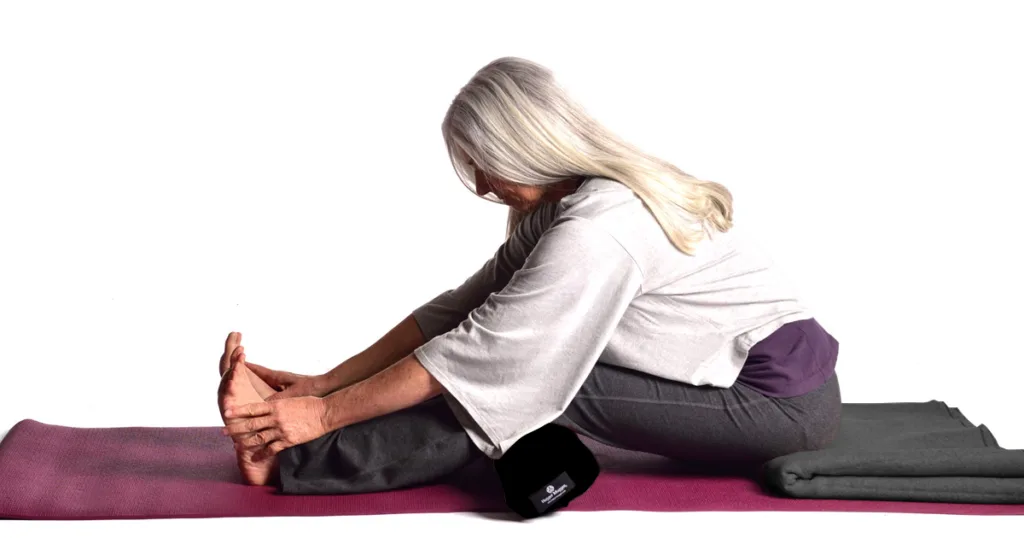This entry was posted on Jan 25, 2024 by Charlotte Bell.

Forward bends are some of yoga’s most common, and iconic, poses. You can practice forward bends from standing, sitting or even lying down. Forward bends promote lengthening in the muscles of the back, hips and hamstrings. Keeping muscles of the back, hips and hamstrings supple can also be healthy for your spine. Relaxed muscles in the hips and hamstrings help you maintain your spine’s natural “S” curves. Tight hamstrings can position the pelvis so that the tailbone is tucked under, a recipe for lumbar disc problems down the road. Practicing seated forward bends with a Yoga Bolster can help promote a healthy spine and calm mind.
It’s important that we maintain continuity between the pelvis and spine while we bend forward. As a general rule of thumb, the pelvis and spine should move together, both to foster continuity and protect the discs, but also to keep the sacroiliac joint in its most stable position.
In seated forward bends, sitting on a Yoga Blanket to encourage forward movement in the pelvis and bending your knees slightly can help keep your pelvis and spine moving together. But using a Yoga Bolster in addition to sitting on a blanket can help us maintain spinal integrity while we bend forward.
Using a Yoga Bolster can also promote another of the benefits of forward bends: calming the mind. When your body is supported with a bolster, you can let go of struggle and allow your body to soften. This helps to calm your mind.
Here are two ways to bolster your forward bends:
Paschimottanasana (Seated Forward Bend): Place a Pranayama Yoga Bolster Under Your Knees
Pranayama Yoga Bolsters are not just for pranayama. They are the perfect size to support your knees in seated forward bends as well.
Their benefits are twofold: First, bending your knees and resting them on a pranayama bolster makes it easier to bend from the pelvis and protect your spine.
Second, people often feel intense stretch in the ligaments and tendons behind their knees when they’re forward bending with their knees straight. Ligaments and tendons are not meant to be stretched excessively because they do not have the “memory”—the ability to resume their original length—that muscles do. (This is why once you’ve sprained your ankle, it’s never as stable as it was before.) Placing a Pranayama Yoga Bolster under your knees takes the stretch out of the ligaments and tendons and focuses it into the hamstrings instead.
Paschimottanasana with a Pranayama Bolster
- Sit in Dandasana (Staff Pose) with your legs outstretched and parallel on a nonskid Yoga Mat.
- Fold a yoga blanket so that it’s about three inches thick. Sit on the blanket so that your pelvis is on the edge and your legs are on the floor. If you feel your pelvis tilting back and your lumbar vertebrae poking out in back, fold another blanket and place it under your pelvis.
- Place a pranayama bolster under your knees.
- To move into the forward bend, tip your pelvic rim forward and lengthen your front body. In other words, lead the forward bend with your pelvis. Keep your spine long as you come forward. It’s okay to gently flex your spine once your pelvis is tipped forward.
- Stay for 5 to 10 deep breaths, allowing your torso to oscillate as you breathe. Check your arms and shoulders. Are you tensing there? How about your facial muscles and throat? Relax where you can. On an inhalation, come up out of the forward bend.
Upavista Konasana (Wide-Legged Seated Forward Bend): Relax with a Slanted Yoga Bolster
Even though forward bends are said to be relaxing, they’re not so relaxing when your body is struggling against gravity and hanging out in space. Placing a slanted Standard Yoga Bolster under your torso allows you to let go of the struggle and settle into gravity.
- Sit on a yoga mat in Upavista Konasana.
- Place a Yoga Block a few feet in front of you at its medium height with the wide side facing you.
- Place a Standard Yoga Bolster on the mat in front of you so that the far end is resting on the block and the end closest to you is a few inches away from your hips. The bolster should be slanted upward, away from your body.
- On an exhalation, relax forward onto the bolster. Depending on the flexibility of your hamstrings, you may be able to rest your entire torso on the bolster, including your forehead. If your hamstrings are on the tighter side, clasp opposite elbows and rest your forearms on the bolster. Either way, relax your head and neck and let your weight settle onto the bolster as much as possible. You can place an extra thickly folded blanket or a yoga block under your forehead if you like.
- Take 5 to 10 deep breaths here. Or if you’re very comfortable and want to make this a Restorative yoga experience, relax here for several minutes,
- On an inhalation, lift your torso off the bolster. Take a few easy breaths before shifting out of the pose.
About Charlotte Bell
Charlotte Bell discovered yoga in 1982 and began teaching in 1986. Charlotte is the author of Mindful Yoga, Mindful Life: A Guide for Everyday Practice and Yoga for Meditators, both published by Rodmell Press. Her third book is titled Hip-Healthy Asana: The Yoga Practitioner’s Guide to Protecting the Hips and Avoiding SI Joint Pain (Shambhala Publications). She writes a monthly column for CATALYST Magazine and serves as editor for Yoga U Online. Charlotte is a founding board member for GreenTREE Yoga, a non-profit that brings yoga to underserved populations. A lifelong musician, Charlotte plays oboe and English horn in the Salt Lake Symphony and folk sextet Red Rock Rondo, whose DVD won two Emmy awards in 2010.

